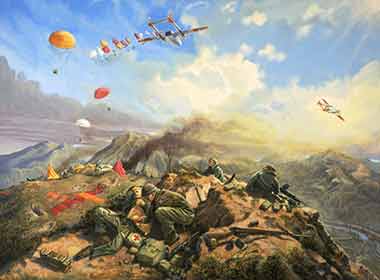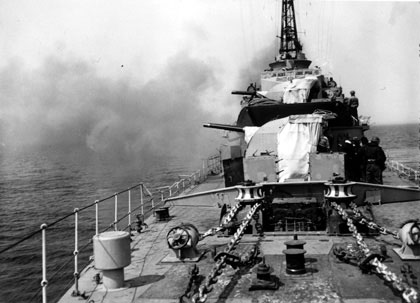Canada Remembers Times - 2013 Edition - Page 1
Download the PDF Version.
PDF Version 6.47 MB
Canada at War in Korea

Canadian Sherman tanks in Korea. July 1952.
(Photo: Library and Archives Canada PA-115496)
After years of rising tensions, North Korea invaded South Korea on June 25, 1950. This act of aggression triggered an international crisis in the place traditionally known as the "Land of the Morning Calm."
The United Nations (UN) voted to send a multinational force to the Far East to intervene. More than 26,000 Canadians would serve during the Korean War. In the summer of 1950, the Royal Canadian Navy sent destroyers to patrol the waters off Korea and the Royal Canadian Air Force began air transport runs between North America and Asia. The Canadian Army would soon send ground forces and our soldiers saw heavy action in places like Kapyong, Chail'li, Hill 355 and "the Hook." Sadly, 516 Canadians gave their lives in service during the war.
An Armistice that ended more than three years of fighting was finally signed on July 27, 1953. Seven thousand Canadians would continue to serve there in a peacekeeping role, with the last ones only leaving in 1957. No peace treaty was ever signed to formally end the war, however, and tensions along the border between North Korea and South Korea remain.
2013 marks the 60th anniversary of the signing of the Armistice and has been designated the "Year of the Korean War Veteran" in Canada. Let's make it a year to remember!
Canadians in the Battle of Kapyong

'Holding at Kapyong' by Ted Zuber.
(Photo: CWM 19900084-001 Beaverbrook Collection of War Art © Canadian War Museum)
Few episodes for our soldiers in Korea were as intense as the experiences of the 2nd Battalion of Princess Patricia's Canadian Light Infantry (PPCLI) during the Battle of Kapyong in the spring of 1951.
The Princess Pats, along with other forces of the 27th Commonwealth Brigade, had been brought forward to defend the Kapyong Valley during an all-out enemy offensive. Their mission was to help prevent the attackers from wiping out the South Korean front line forces and possibly even capturing Seoul.
On the night of April 24, the Canadians came under intense fire and were rushed by waves of charging enemy soldiers. At times the Canadian defences were overrun and our men even called in an artillery strike on their own positions, taking cover in their shallow trenches as the exploding shells drove off the exposed attackers. The next morning, the situation was still desperate—the Canadians were surrounded. Ammunition and food were running low. They had to get new supplies dropped by air. Fortunately, the Chinese broke off their attack in the Kapyong Valley soon after.
The Canadians had successfully held out against a much larger attacking force, but it came at a high price with 10 Canadians being killed and 23 wounded. The Battalion received the United States Presidential Unit Citation for its members' bravery in Kapyong, a rare honour for a non-American military unit.
The Trainbusters Club

Royal Canadian Navy destroyer firing off coast of Korea in 1951.
(Photo: Library and Archives Canada PA-142437)
The Royal Canadian Navy served in many ways during the Korean War. One of the most interesting roles our destroyers played was being part of the "Trainbusters Club" with the United Nations (UN) fleet.
The mountainous terrain in the eastern portion of the Korean Peninsula often forced rail lines to hug the coast, which made enemy trains tempting targets for our warships patrolling offshore. Damaging trains and railway tracks helped the UN war effort as it made it harder for the opposing side to transport supplies.
This task was difficult and sometimes dangerous. On October 2, 1952, HMCS Iroquois was exchanging fire with an enemy gun battery on shore when it took a direct hit. Three Canadians died and ten were wounded in the explosion—our navy's only combat casualties in the war.
Hockey Night in Korea

Brigadier J.M. Rockingham drops the puck at a hockey game in Korea in February 1952.
(Photo: Library and Archives Canada PA-184478)
Canadians will be Canadians, no matter where in the world they are. As the Korean War progressed and the front lines became more stationary, our soldiers would play hockey games on the ice of the nearby Imjin River in the winter time as the sound of artillery fire boomed in the distance.
The matches were often between different units with pride and bragging rights on the line. On March 11, 1952, players from the 1st Battalion of Princess Patricia's Canadian Light Infantry and the 2nd Battalion of the Royal 22e Régiment faced off. This championship game was held on the makeshift outdoor rink dubbed "Imjin Gardens." The sporting event helped create a little piece of normal Canadian life half a world away in war-torn Korea.
This tradition continues in more recent times, with Canadian Armed Forces members playing ball hockey in far-off places like Afghanistan.
Canadian Women in the Korean War

Canadian servicewomen in Korea.
(Photo: George Metcalf Archival Collection,
Candian War Museum 19820095-005)
When the Korean War broke out, Canadian women were again recruited for service in our country's army, navy and air force. More than 5,000 would serve both at home and overseas. Nursing Sisters often had to provide aid in a combat zone where they treated battle injuries and diseases. They also flew air evacuation with casualties back to Canada. When the Armistice came into effect in 1953, they worked with the newly released prisoners of war, helping to restore their health. Fortunately, there were no female Canadian casualties.
Explore the "Land of the Morning Calm"
Check out the interactive, multimedia web feature about the Korean War. Hear about the events leading up to the outbreak of the conflict, watch interviews with Canadian Veterans who fought there, and explore the interactive time line and maps. Visit "Land of the Morning Calm" today!
- Date modified: